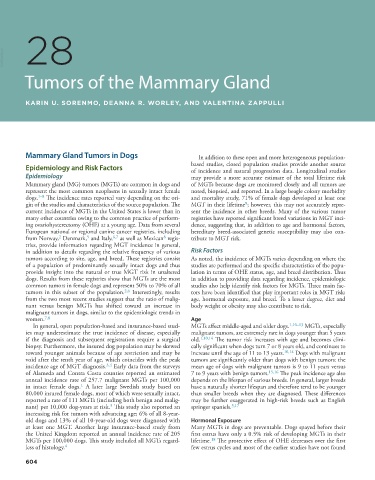Page 626 - Withrow and MacEwen's Small Animal Clinical Oncology, 6th Edition
P. 626
28
VetBooks.ir
Tumors of the Mammary Gland
KARIN U. SORENMO, DEANNA R. WORLEY, AND VALENTINA ZAPPULLI
Mammary Gland Tumors in Dogs In addition to these open and more heterogeneous population-
Epidemiology and Risk Factors based studies, closed population studies provide another source
of incidence and natural progression data. Longitudinal studies
Epidemiology may provide a more accurate estimate of the total lifetime risk
Mammary gland (MG) tumors (MGTs) are common in dogs and of MGTs because dogs are monitored closely and all tumors are
represent the most common neoplasms in sexually intact female noted, biopsied, and reported. In a large beagle colony morbidity
dogs. 1–8 The incidence rates reported vary depending on the ori- and mortality study, 71% of female dogs developed at least one
9
gin of the studies and characteristics of the source population. The MGT in their lifetime ; however, this may not accurately repre-
current incidence of MGTs in the United States is lower than in sent the incidence in other breeds. Many of the various tumor
many other countries owing to the common practice of perform- registries have reported significant breed variations in MGT inci-
ing ovariohysterectomy (OHE) at a young age. Data from several dence, suggesting that, in addition to age and hormonal factors,
European national or regional canine cancer registries, including hereditary breed-associated genetic susceptibility may also con-
6,7
8
5
from Norway, Denmark, and Italy, as well as Mexican regis- tribute to MGT risk.
2
tries, provide information regarding MGT incidence in general,
in addition to details regarding the relative frequency of various Risk Factors
tumors according to site, age, and breed. These registries consist As noted, the incidence of MGTs varies depending on where the
of a population of predominantly sexually intact dogs and thus studies are performed and the specific characteristics of the popu-
provide insight into the natural or true MGT risk in unaltered lation in terms of OHE status, age, and breed distribution. Thus
dogs. Results from these registries show that MGTs are the most in addition to providing data regarding incidence, epidemiologic
common tumors in female dogs and represent 50% to 70% of all studies also help identify risk factors for MGTs. Three main fac-
2,6
tumors in this subset of the population. Interestingly, results tors have been identified that play important roles in MGT risk:
from the two most recent studies suggest that the ratio of malig- age, hormonal exposure, and breed. To a lesser degree, diet and
nant versus benign MGTs has shifted toward an increase in body weight or obesity may also contribute to risk.
malignant tumors in dogs, similar to the epidemiologic trends in
women. 7,8 Age
In general, open population-based and insurance-based stud- MGTs affect middle-aged and older dogs. 1,10–13 MGTs, especially
ies may underestimate the true incidence of disease, especially malignant tumors, are extremely rare in dogs younger than 5 years
if the diagnosis and subsequent registration require a surgical old. 1,10,14 The tumor risk increases with age and becomes clini-
biopsy. Furthermore, the insured dog population may be skewed cally significant when dogs turn 7 or 8 years old, and continues to
toward younger animals because of age restriction and may be increase until the age of 11 to 13 years. 10,14 Dogs with malignant
void after the tenth year of age, which coincides with the peak tumors are significantly older than dogs with benign tumors: the
3,4
incidence age of MGT diagnosis. Early data from the surveys mean age of dogs with malignant tumors is 9 to 11 years versus
of Alameda and Contra Costa counties reported an estimated 7 to 9 years with benign tumors. 15,16 The peak incidence age also
annual incidence rate of 257.7 malignant MGTs per 100,000 depends on the lifespan of various breeds. In general, larger breeds
in intact female dogs. A later large Swedish study based on have a naturally shorter lifespan and therefore tend to be younger
1
80,000 insured female dogs, most of which were sexually intact, than smaller breeds when they are diagnosed. These differences
reported a rate of 111 MGTs (including both benign and malig- may be further exaggerated in high-risk breeds such as English
3
nant) per 10,000 dog-years at risk. This study also reported an springer spaniels. 3,17
increasing risk for tumors with advancing age; 6% of all 8-year-
old dogs and 13% of all 10-year-old dogs were diagnosed with Hormonal Exposure
at least one MGT. Another large insurance-based study from Many MGTs in dogs are preventable. Dogs spayed before their
the United Kingdom reported an annual incidence rate of 205 first estrus have only a 0.5% risk of developing MGTs in their
18
MGTs per 100,000 dogs. This study included all MGTs regard- lifetime. The protective effect of OHE decreases over the first
less of histology. 4 few estrus cycles and most of the earlier studies have not found
604

